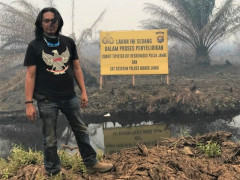Saving the Muaro Jambi Peat Orchid
By Yitno SupraptoMapping 200,000 Hectares of Peatland in Jambi

LiDAR-based mapping for peat restoration started in the Muaro Jambi and East Tanjung Jabung districts. The initiative mapped 200,000 hectares of peatland between Saturday, November 25 and the end of December 2017. According to City Post, this program was a follow-up to the 50,000-ha mapping initiative conducted in Pontianak.
On Thursday, November 23, 2017, the Peatland Restoration Agency (BRG) and the Regional Peat Restoration Team held an introductory session on mapping with Light Detection and Ranging (LiDAR) technology in the Peat Hydrological Unit (KHG) of the Batanghari and Mendahara rivers.
Citing Tribun News, BRG representative Thomas Rinuwan stated that LiDAR mapping was part of their ongoing efforts to restore degraded peatlands in the Jambi region. “We are conducting this introductory session because the BRG has begun mapping peatland areas with the support of PT ASI Pudjiastuti Geosurvey,” he explained.
This laser-based mapping for peat restoration started in the Muaro Jambi and East Tanjung Jabung districts. The initiative mapped 200,000 hectares (ha) of peatland between Saturday, November 25 and the end of December 2017.
According to City Post, this program was a follow-up to the 50,000-ha mapping initiative conducted in Pontianak. According to Iwan Qodar, the Director of PT ASI Pudjiastuti Geosurvey, “The results of LiDAR mapping can be used to determine locations for canal blocking or vegetation planting in peatland areas.”
Kompas states that LiDAR can generate detailed geospatial data at a scale of 1:1000, so it can be used to support technical work, such as determining the optimal location for canal blocking and distinguishing peatland depths.
This information is useful in applying the rewetting technique to restore peat’s ability to hold carbon. Additionally, the results of LiDAR mapping in Jambi and Kalimantan can be used by other institutions interested in contributing to peat restoration.
Millennium Challenge Account Indonesia (MCA-I) – BRG’s main partner for LiDAR mapping in Jambi – aimed to complete data processing by the end of January 2018. In addition to MCA-I’s work, the BRG and the Geospatial Information Agency have conducted LiDAR mapping in four priority districts: Musi Banyuasin, Ogan Komering Ilir, Pulang Pisau, and Meranti. To date, the BRG has mapped six KHGs.
MCA-I supports the restoration of two million ha of peatland targeted by the BRG. So far, they have succeeded in revegetating 130 ha out of 250 ha of Londerang Protected Peat Forest and Berbak National Park in Jambi. Meanwhile, due to funding and time limitations, MCA-I has only wet 16,000 ha of peatland. MCA-I has integrated restoration efforts by conducting mapping, constructing canal blocking, and rewetting peat. This approach will speed up peatland restoration efforts in Indonesia.



